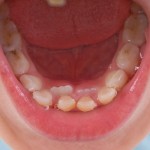
The aim of this study was to compare the use of ferric sulphate (FS), formocresol (FC), mineral trioxide aggregate (MTA) and sodium hypochlorite (NaOCl) as pulp dressing following pulpotomy in primary molars.
Symptom-free vital primary molars with carious pulp exposure with the possibility of proper restoration of the teeth with a minimum of three walls of the tooth present; and no resorption of more than one-third of the root were included. The molars were randomised to either the control (FC) or experimental (MTA, ferric sulphate, and NaOCl) groups. Standardised clinical procedures were conducted with teeth being restored with stainless steel crowns. Patients were clinically and radiographically followed up at 6, 12, 18, and 24 months.
- 81 patients (100 primary molars) were included. Only 61 molars were available was assessment at 24 months, with 16% drop out in FC group and 40%, 56% and 52% in the MTA, FS and NaOCL groups respectively.
- 100% of the available teeth were clinically successful at all follow-up appointments in the FC and MTA groups
- In the NaOCl group, one clinical failure was found at 18 months, and two clinical failures in the ferric sulphate group were noted at 12 and 24 months, but no significant differences were found among the groups (P = 0.41). No significant differences in radiographic success were found among all the groups at 24 months of follow-up (P = 0.303).
The authors concluded
No statistically significant differences among the four materials were found at 24 months suggesting that NaOCl may be an appropriate substitute for FC.
Comment
Because caries remains a significant problem in children the need to manage pulpally involved primary molars effectively remains an issue. The use of FC for primary molar pulpotomy is controversial as noted by the authors so this study comparing different medicaments is interesting. The authors discuss the challenge of compliance and the dropout rates and also touch on the issue of exfoliation. However, with the high level of drop out seen in the three of the groups (all over 40%) it is difficult to agree with their final conclusion. In addition with the inclusion of 100 teeth from 81 patients the issue of clustering should also have been taken into account.
Recently a systematic review of MTA for endodontic treatment in primary teeth has been published (see Dental Elf 5th Dec 2012)
Links
Fernández CC, Martínez SS, Jimeno FG, Lorente Rodríguez AI, Mercadé M. Clinical and radiographic outcomes of the use of four dressing materials in pulpotomized primary molars: a randomized clinical trial with 2-year follow-up. Int J Paediatr Dent. 2012 Nov 21. doi: 10.1111/ipd.12009. [Epub ahead of print] PubMed PMID: 23171351.
Dental Elf 5th Dec 2012 – Mineral trioxide for endodontic treatment of primary molars
